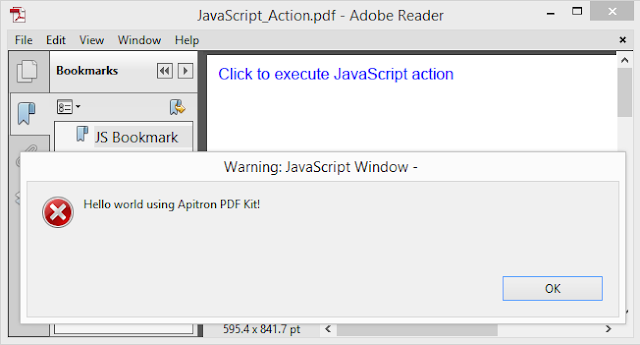Introduction
In our latest
post we’ve explored all possible ways to use links in PDF and promised to
write an additional post about pdf actions. As you may recall, we used Destination objects for setting the targets
of our links. Another way to get job done and extend the range of possible
usages is to use Actions. They are
described in section 12.6 “Actions” of
the pdf specification and provide an alternative way to add interactivity to
your documents.
In addition to jumping to a
destination, actions can be used to launch application, execute Adobe
JavaScript, play sound, change annotation’s appearance state, etc.
All available action types are listed
below:
- GoTo - go to a destination in the current document
- GoToR - (“Go-to remote”) go to a destination in another document
- GoToE - (“Go-to embedded”) go to a destination in an embedded file
- Launch - launch an application, usually to open a file
- Thread - begin reading an article thread
- URI - resolve a uniform resource identifier
- Sound - play a sound
- Movie - play a movie
- Hide - set an annotation’s Hidden flag
- Named - execute an action predefined by the conforming reader
- SubmitForm - send data to a uniform resource locator
- ResetForm - set fields to their default values
- ImportData - import field values from a file
- JavaScript - execute a JavaScript code
- Rendition - controls the playing of multimedia content
- Trans - updates the display of a document, using a transition dictionary
- GoTo3DView - sets the current view of a 3D annotation
Actions can be assigned to annotations objects and outline items (“bookmarks”), see the code sample provided in the next section.
Code sample
Below is the slightly modified
code sample from the post about links, its only difference is the use of Action object instead of Destination. It creates a bookmark and a
link both having the same JavaScript action assigned. This action shows a
simple message box with “hello world” message.
public void CreateLinkAndBookmarkWithJavaScriptAction()
{
//
create pdf document
FixedDocument doc = new FixedDocument();
//
create javascript action, showing the message box
Action action = new JavaScriptAction("app.alert('Hello
world using
Apitron PDF Kit!');");
// add a
bookmark for second page
doc.Bookmarks.AddFirst(new Bookmark(action, "JS Bookmark"));
// add
first page with text link
Page firstPage = new Page();
// add
link text
TextObject linkTextObject = new TextObject();
linkTextObject.AppendTextLine("Click to execute JavaScript action");
firstPage.Content.SaveGraphicsState();
firstPage.Content.SetDeviceNonStrokingColor(RgbColors.Blue.Components);
firstPage.Content.Translate(10, 820);
firstPage.Content.AppendText(linkTextObject);
firstPage.Content.RestoreGraphicsState();
// add
link annotation covering the text
LinkAnnotation link = new LinkAnnotation(new Boundary(10, 815, 230, 835));
link.BorderStyle = new AnnotationBorderStyle(0);
link.Action = action;
firstPage.Annotations.Add(link);
//
append pages
doc.Pages.Add(firstPage);
// save
document
using (Stream stream = File.Create("JavaScript_Action.pdf"))
{
doc.Save(stream);
}
}
See the image below showing the results of clicking the link
with assigned action.
It’s easy and simple as it should
be. If you’d like to read more about Adobe’s JavaScript implementation, read
the following book - “JavaScript™ for Acrobat® API Reference”.
Conclusion
As you can see, our product, Apitron PDF Kit for .NET, can be
used to add interactivity to your pdf documents with unmatched ease and
clearness. Using its API you’ll be able to:
create links, actions and bookmarks, create or modify pdf forms, and
much more. Read our free book,
or contact our support if you have any questions regarding its capabilities.
Downloadable version of this article can be found by the following link [PDF].
Downloadable version of this article can be found by the following link [PDF].

No comments:
Post a Comment